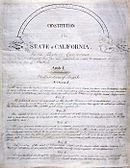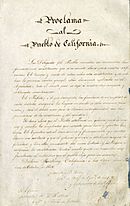Politics of California facts for kids
The politics of California are how the state is governed and how people make decisions about its future. It's a bit like a big team working together, but sometimes with different ideas!
Contents
Government
In California's government, there's an important group called the Big Five. This group includes the governor, the leader of the Assembly (called the Speaker), the Assembly's minority leader, the leader of the Senate (called the president pro tempore), and the Senate's minority leader.
These five leaders meet privately to talk about new laws. Because they also control money for their political parties, they have a lot of power. This helps them guide how their party members vote in these important meetings.
Electoral System
In California's main government, only the Democratic Party and Republican Party currently have members. However, for a short time, the Green Party had one member in the State Assembly.
California uses a special way to choose candidates called a non-partisan blanket primary. In this system, all candidates, no matter their party, run against each other. The two candidates who get the most votes then go on to the main election.
Some cities, like San Francisco and Berkeley, use a different system called ranked-choice voting (also known as instant-runoff voting). This is where voters rank candidates in order of their preference, instead of just picking one.
For local elections in cities and counties, political parties are not listed on the ballot. If no candidate wins more than half the votes in the first round, the top two candidates have a second election (a runoff).
Electoral History
California first voted for president in 1852, choosing Democrat Franklin Pierce. For many years after the Civil War, California often voted Republican, but it was a close race. Around the early 1900s, it became a strong Republican state.
Then, starting in 1932, California began to vote more for Democrats. Franklin D. Roosevelt won nearly all counties in 1932 and all counties in 1936. After a period where it was a "battleground state" (meaning it could go either way), California has become very Democratic since the 1992 presidential election. It has voted Democratic in every presidential election since then, often by a large amount.
Generally, people in coastal areas like the Bay Area, Los Angeles, and San Diego tend to vote Democratic. People in inland areas and the Central Valley often vote Republican. However, Democrats have been gaining more support in inland areas too.
At the state level, like for governor, California's voting has been more mixed. Control of the governor's office has often switched between the two main parties.
Political Parties
The two biggest political parties in California are the Democratic Party and the Republican Party. These are the only parties with members in the state government and U.S. Congress.
There are also four other parties that can be on the official ballot:
- American Independent Party
- Green Party
- Libertarian Party
- Peace and Freedom Party
As of April 2022, about 46.75% of registered voters in California are Democrats, and about 23.92% are Republicans. Many voters, about 22.77%, choose not to be part of any party.
Political Issues
Many of California's government rules and programs are set in the Constitution of California. This includes how much money certain parts of the government must receive. This can cause problems, especially when the state needs to save money. For example, in the 2000s, Governor Arnold Schwarzenegger tried to cut spending, but the California Supreme Court sometimes ordered money to be put back into certain programs.
Over the years, California has faced several big political challenges:
- Term Limits: Rules were passed to limit how long people can serve in the state legislature and other elected jobs. This was a big debate!
- Judges Removed: There was a time when a chief justice and two other judges of the Supreme Court were voted out by the public.
- Proposition 13: This law changed how property taxes are collected. It froze property tax rates at 1% of the last sale price, with only small increases each year.
- Recall Election: In 2003, Governor Gray Davis was removed from office by a special election, where voters decided to "recall" him.
- Budget Delays: In 2008, the state government couldn't agree on a budget for almost three months after it was supposed to be finished.
California's voting patterns show a clear divide. The inland areas of Northern California and the Central Valley tend to vote Republican. However, areas like Orange County and Riverside County in Southern California, which used to be strong Republican areas, have been voting more Democratic recently. The coastal areas, including the Bay Area, Los Angeles, San Diego, and Sacramento, are mostly Democratic. Since most people live in Southern California and the Bay Area, the state as a whole tends to lean Democratic.
California was a Republican stronghold in presidential elections from 1952 to 1992. During this time, Republicans won California in almost every election. This was partly because famous Californians like Richard Nixon and Ronald Reagan ran for president. But since 1992, Democrats have won every presidential election in California. This shift happened because more Hispanic Americans and Asian Americans moved to the state, and many people from other states who tend to vote Democratic also moved to California.
One big issue in California is water. California doesn't get much rain in the dry season, so water is limited. Most of the water comes from mountains in the north, but most of the farms and people are in the central and southern parts of the state. This leads to disagreements about how to share the water. People in the south want more water, but people in the north say it's needed for the environment, farms, and wildlife.
Land use is another important issue. Because land prices are very high, many people's savings are tied up in their homes. This makes them care a lot about anything that could change their property values. Local fights often happen over things like school quality (which affects home prices) and where to build new things like airports or dumps.
Gun control is also a big topic. California has strict gun laws. For example, it's very hard to buy certain types of semi-automatic rifles. Handguns can be kept at home or work, but it's usually illegal to carry them outside without a special permit. These permits are very hard to get in most parts of the state. This means that people in rural areas might be able to carry guns more easily than those in cities, leading to different rules depending on where you live.
Influence of Special-Interest Groups
California is the state with the most people in the United States. This means that laws and decisions made in California can have a big impact on the whole country. Because of this, special-interest groups (groups that try to influence government decisions), even those from outside California, play a big role in the state's politics. They spend a lot of money to influence voters and elected officials through lobbying, lawsuits, and advertisements. The California Fair Political Practices Commission is the group that watches over campaign money and lobbying in California.
Gerrymandering
Congressional Representation
Because California has so many people, it has the largest group of representatives in the U.S. Congress. It has 53 representatives in the House and two senators.
Many important leaders in Congress are from California.
- Among Democrats:
- Rep. Nancy Pelosi from the 12th District, who used to be the Speaker of the House.
- Senator Dianne Feinstein.
- Vice-President Kamala Harris, who is also the Vice President of the United States and leads the Senate.
- Among Republicans:
- Rep. Kevin McCarthy from the 23rd District, who used to be the Minority Leader in the House.
- Rep. Devin Nunes from the 22nd District.
- Rep. Darrell Issa from the 50th District.
See also
 In Spanish: Política de California para niños
In Spanish: Política de California para niños



